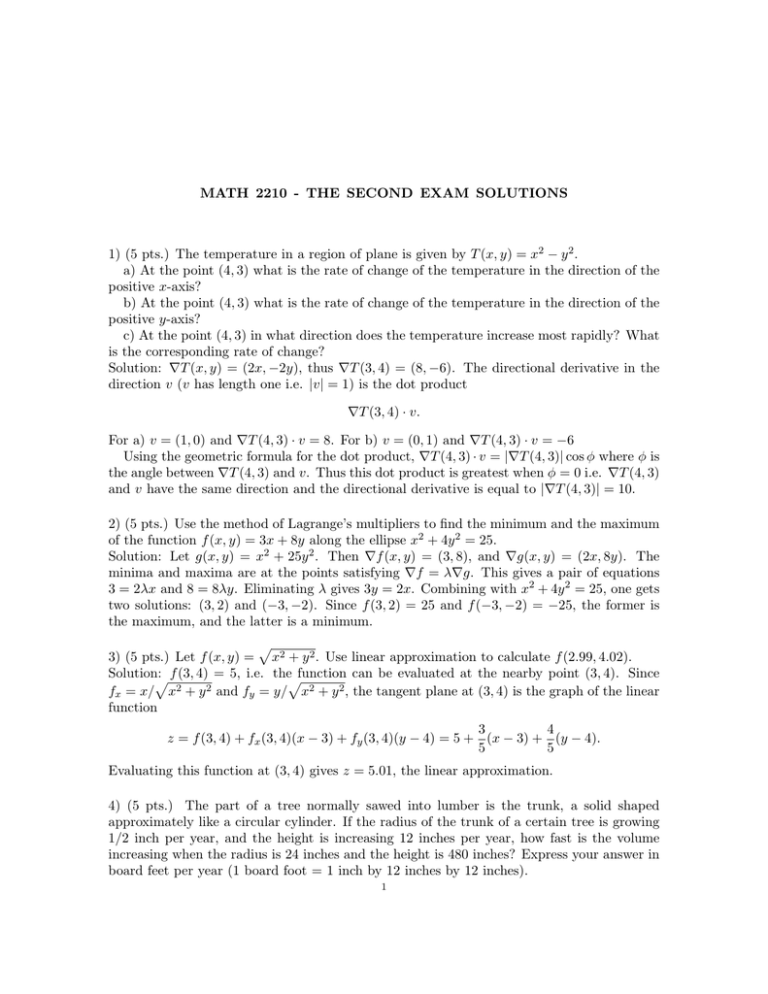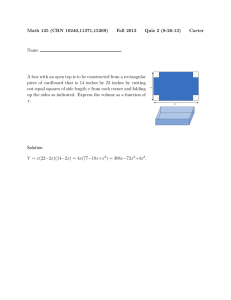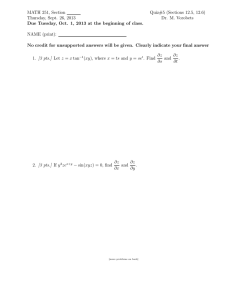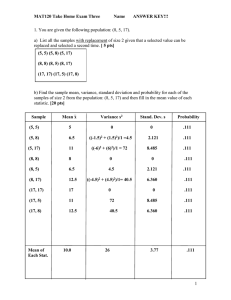MATH 2210 - THE SECOND EXAM SOLUTIONS − y
advertisement

MATH 2210 - THE SECOND EXAM SOLUTIONS 1) (5 pts.) The temperature in a region of plane is given by T (x, y) = x2 − y 2 . a) At the point (4, 3) what is the rate of change of the temperature in the direction of the positive x-axis? b) At the point (4, 3) what is the rate of change of the temperature in the direction of the positive y-axis? c) At the point (4, 3) in what direction does the temperature increase most rapidly? What is the corresponding rate of change? Solution: ∇T (x, y) = (2x, −2y), thus ∇T (3, 4) = (8, −6). The directional derivative in the direction v (v has length one i.e. |v| = 1) is the dot product ∇T (3, 4) · v. For a) v = (1, 0) and ∇T (4, 3) · v = 8. For b) v = (0, 1) and ∇T (4, 3) · v = −6 Using the geometric formula for the dot product, ∇T (4, 3) · v = |∇T (4, 3)| cos φ where φ is the angle between ∇T (4, 3) and v. Thus this dot product is greatest when φ = 0 i.e. ∇T (4, 3) and v have the same direction and the directional derivative is equal to |∇T (4, 3)| = 10. 2) (5 pts.) Use the method of Lagrange’s multipliers to find the minimum and the maximum of the function f (x, y) = 3x + 8y along the ellipse x2 + 4y 2 = 25. Solution: Let g(x, y) = x2 + 25y 2 . Then ∇f (x, y) = (3, 8), and ∇g(x, y) = (2x, 8y). The minima and maxima are at the points satisfying ∇f = λ∇g. This gives a pair of equations 3 = 2λx and 8 = 8λy. Eliminating λ gives 3y = 2x. Combining with x2 + 4y 2 = 25, one gets two solutions: (3, 2) and (−3, −2). Since f (3, 2) = 25 and f (−3, −2) = −25, the former is the maximum, and the latter is a minimum. p 3) (5 pts.) Let f (x, y) = x2 + y 2 . Use linear approximation to calculate f (2.99, 4.02). Solution: p f (3, 4) = 5, i.e. thepfunction can be evaluated at the nearby point (3, 4). Since fx = x/ x2 + y 2 and fy = y/ x2 + y 2 , the tangent plane at (3, 4) is the graph of the linear function 3 4 z = f (3, 4) + fx (3, 4)(x − 3) + fy (3, 4)(y − 4) = 5 + (x − 3) + (y − 4). 5 5 Evaluating this function at (3, 4) gives z = 5.01, the linear approximation. 4) (5 pts.) The part of a tree normally sawed into lumber is the trunk, a solid shaped approximately like a circular cylinder. If the radius of the trunk of a certain tree is growing 1/2 inch per year, and the height is increasing 12 inches per year, how fast is the volume increasing when the radius is 24 inches and the height is 480 inches? Express your answer in board feet per year (1 board foot = 1 inch by 12 inches by 12 inches). 1 2 MATH 2210 - THE SECOND EXAM SOLUTIONS Solution: V = πr2 h. Thus dV ∂V dr ∂V dh dr dh = + = 2πrh + πr2 dt ∂r dt ∂h dt dt dt In the moment when r = 24, and h = 480 dV 1 = 2π24 · 480 · + π(24)2 · 12 dt 2 cubic inches per year. Do not simplify the expression. Since one board foot is 122 cubic inches, dividing the above by 122 gives 128π board feet per year. 5) (5 pts.) Find and determine the nature of all critical points of the function f (x, y) = (x3 − 3x)(1 + y 2 ). Solution: Do not multiply out the factors! fx = (3x2 − 3)(1 + y 2 ) and fy = (x3 − 3x)2y. Since 1 + y 2 > 0, fx = 0 if and only if x = 1 or −1. Since x3 − 3x 6= 0 for x = 1 or −1, fx = 0 AND fy = 0 only for (x, y) = (1, 0) and (−1, 0). Both are saddle points.








